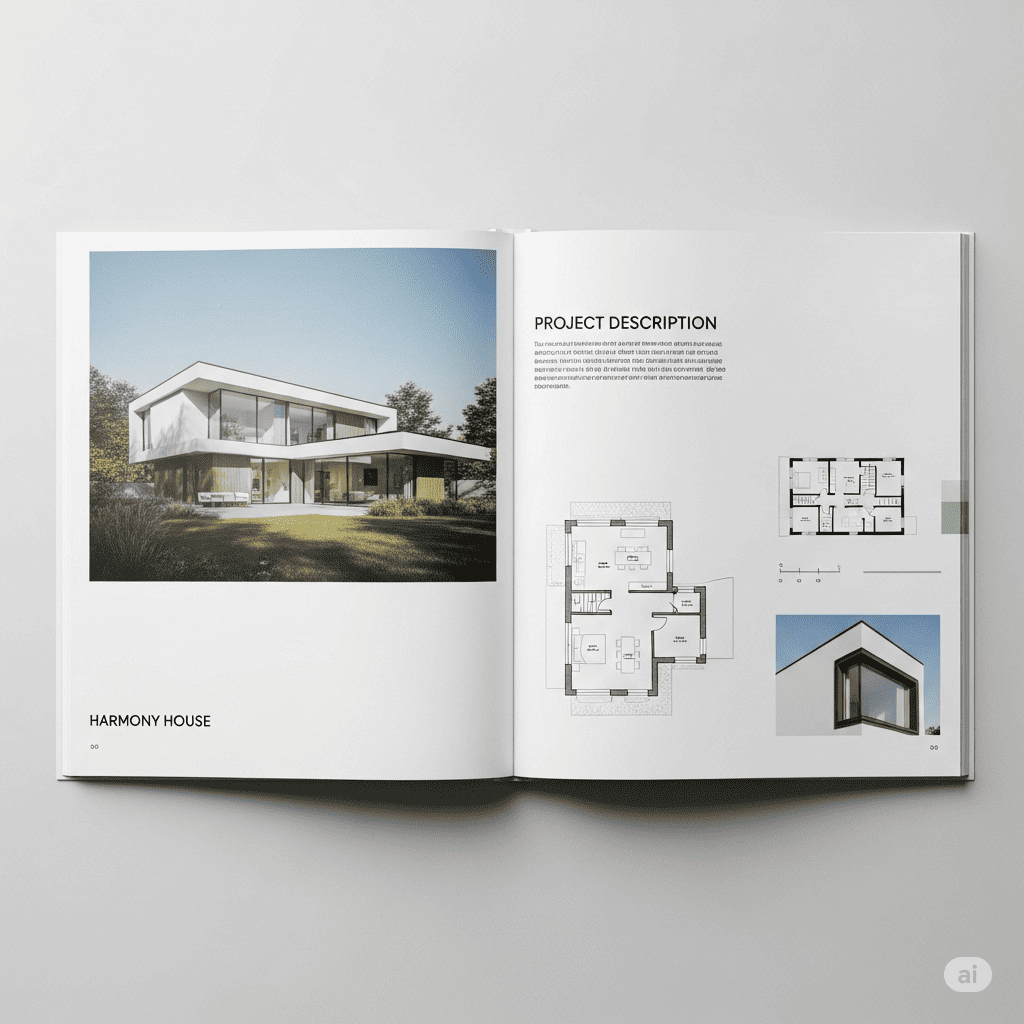What Makes an Architecture Portfolio SEO-Friendly
You Can’t Land High-Ticket Projects with a Ghost Portfolio
Your portfolio is your storefront.
And in architecture, it’s not just a gallery of pretty pictures—it’s your SEO engine, your silent salesperson, your first trust filter.
Here’s the brutal truth:
If your portfolio isn’t showing up in search, it might as well not exist.
At Adswom, we help architects and designers turn beautiful portfolios into lead-generating, SEO-optimised machines. This guide will show you exactly how to build a portfolio that doesn’t just impress—it ranks, converts, and closes.
Key Takeaways
- A beautiful portfolio isn’t enough—visibility beats aesthetics.
- Each project page should be treated as its own SEO asset.
- Optimizing images (names, alt text, schema) is non-negotiable.
- Fast, mobile-first portfolios signal precision and trust.
- Storytelling, structure, and CTAs turn browsers into inquiries.

The Myth That Kills Most Portfolios
Most architects believe: “If my work is beautiful, clients will find me.”
But Google doesn’t care how stunning your images are. It only cares about:
- Structure (is the site crawlable?)
- Speed (does it load fast?)
- Context (are visuals described in language search engines understand?)
- Accessibility (can both users + bots “read” your portfolio?)
You’re not competing on design aesthetics. You’re competing for search real estate.
Treat Every Project Page as an SEO Asset
Think of your portfolio as a keyword battlefield.
Google doesn’t understand “Projects” or “Our Work.” It understands intent-driven project pages. That’s why each portfolio item needs its own SEO strategy.
Every project should include:
- A unique URL:
/luxury-modern-villa-los-angeles - A keyword-rich H1: Luxury Modern Villa in Los Angeles
- Optimised meta title/description with location + style keywords
- Long-tail keywords woven in: “sustainable modern residential design LA”
Your peers may admire your visuals, but your clients are searching for “luxury villa architect Miami.” If your project pages don’t reflect that, you’re invisible.
Image SEO Is Not Optional
Your visuals are your product. But if you’re uploading files as IMG_4392.jpg, you’re throwing away discovery opportunities.
Image SEO checklist:
- Filenames: modern-glass-villa-los-angeles.jpg
- Alt Text: “Luxury sustainable villa designed by XYZ Studio in Los Angeles”
- Compression: Use WebP or compressed JPGs to keep pages fast
- Captions: Add context under images—Google reads these
- Schema: Use
ImageObjectandRealEstateListing
Done right, every photo in your gallery becomes a magnet in Google Images, Pinterest, and visual search.
Is Your Portfolio Invisible?
At Adswom, we audit portfolios like a luxury buyer would: with sharp eyes and strict standards.
✅ Identify ranking blockers
✅ Analyze technical SEO gaps
✅ Turn visuals into lead magnets
👉 Book Your Free Portfolio SEO Diagnostic →
No pressure. Just truth.
Page Speed = Perceived Precision
Luxury clients equate speed with precision. If your site takes 7 seconds to load, they assume your process is sloppy too.
Common speed killers:
- Gigantic, uncompressed image files
- Heavy JavaScript galleries
- No lazy loading
- No CDN
Quick fixes:
- Compress images (TinyPNG, Squoosh)
- Enable lazy loading for galleries
- Host on a CDN for global delivery
- Audit monthly with PageSpeed Insights
Fast = premium. Slow = sloppy.
Mobile Optimisation Is Non-Negotiable
Over 65% of architecture site traffic is mobile. Yet most portfolios are designed desktop-first.
For high-value clients on the move, mobile friction = instant bounce.
Mobile SEO must-haves:
- Responsive design built mobile-first
- Stack modules instead of shrinking grids
- Thumb-friendly CTAs (“Book Consultation”)
- Legible, concise copy
A high-end portfolio should feel flawless on any device—like a luxury product.
Structure Like You Mean Business
Google reads your hierarchy. Clients read your clarity. Both matter.
Best practice structure:
/projects
/modern-villa-los-angeles
/sustainable-townhouse-nyc
/glass-courtyard-home-miami
Each project page should:
- Open with a keyword-rich H1
- Use H2s: Design Brief, Challenges, Solutions, Materials, Testimonials
- Link to other relevant projects + blogs
Don’t bury great work in bloated grids. Surface it with a crawlable, logical structure.
Storytelling Turns Time-on-Page into Trust
SEO isn’t just robots—it’s humans. Storytelling keeps both engaged.
High-value clients want context:
- What was the design challenge?
- What constraints did you overcome?
- What was the outcome?
Example project copy:
“This modern villa in Hollywood Hills was designed for a tech entrepreneur seeking privacy and sustainability. We maximised canyon views while minimising solar gain, using triple-glazed walls and local biophilic materials.”
Storytelling increases time-on-page, which Google rewards—and clients trust.
Internal Linking = Hidden Growth Lever
If your portfolio isn’t linking to your services, blogs, or press mentions, you’re leaving SEO equity on the floor.
Smart linking examples:
- “Sustainable villa LA” → blog: How Luxury Meets Sustainability
- “Glass home” → service page: Residential Architecture Services
- “Coastal retreat” → PR feature: Featured in Dwell
Internal linking compounds authority and helps clients see your expertise in context.
Schema Markup = Rich Results
Plain links blend in. Rich snippets stand out.
Portfolio schema to add:
ImageObject(for visuals)Project(scope, outcomes)Review/Testimonial(social proof)BreadcrumbList(navigation clarity)
That’s the difference between “plain blue link” vs “Luxury villa | 5 stars | Designed by XYZ Studio.”
Don’t Just Showcase Projects—Rank Them
A project page isn’t an archive. It’s a magnet.
Every project should target:
- One long-tail keyword: “Luxury villa architect Miami”
- One buyer intent: Ready-to-hire clients
- One location: Where the project is or the client is searching from
Boost authority with supporting content:
- Write a blog on the design principles used
- Link blog ↔ project page
- Create a flywheel that drives visibility both ways
Conversion-Ready = Revenue-Ready
All the rankings in the world don’t matter if nobody inquires.
Portfolio conversion checklist:
- Clear CTAs on every page
- Short, frictionless forms (no 12 fields)
- Lead qualification baked in
Example CTA: “Loved this project? Let’s talk. Schedule a 20-minute design consultation.”
Your portfolio isn’t just an archive. It’s a pipeline.
SEO-Friendly Architecture Portfolios
1. What makes an architecture portfolio SEO-friendly?
Each project has its own SEO optimisation: keywords, metadata, fast loading, responsive design, and optimised visuals.
2. How do I optimise images for SEO?
Use descriptive filenames, keyword-rich alt text, next-gen formats, and schema.
3. Can projects rank individually?
Yes. Each should target a keyword + location combo and act as a landing page.
4. What role does storytelling play?
It boosts engagement, signals expertise, and builds client trust.
5. How do I link portfolio pages with other site content?
Use contextual links to blogs, service pages, and PR mentions for authority and navigation.
Don’t Just Build a Portfolio. Build a Ranking Asset.
Most architects stop at aesthetics. But if you want high-value clients, your portfolio needs to be more.
That means:
- Optimizing every page and image
- Structuring for crawlability
- Writing stories that build trust
- Linking strategically
- Capturing inquiries intentionally
Your best work deserves to be seen, ranked, and hired for. With Adswom’s Search-to-SQL approach, your portfolio stops being invisible and starts being your most powerful client acquisition engine.
Writing team:

Les't communicate.
Recent Articles
 The Real Cost of Generic SEO for High-End Architecture and Interior Design Studios
The Real Cost of Generic SEO for High-End Architecture and Interior Design Studios
 Why Generalist SEO Fails Designers — And What to Do Instead
Why Generalist SEO Fails Designers — And What to Do Instead
 What to Look for in an SEO Agency: A Strategic Guide for Architects and Design Firms
What to Look for in an SEO Agency: A Strategic Guide for Architects and Design Firms

